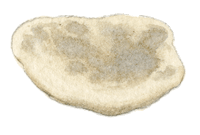Bush bread

Form: flat
Country of origin: Australia (Bush)
What distinguishes it from other methods of bread making: Made with seeds, tubers, and bulbs of plants that Aborigines have known for eons
Category of bread: (2 and 6) Belongs to large family of flat breads, and benefits from respect for ancestral knowledge
Particularity: Some of the grains and roots used in this bread contain toxic substances and require an extra-long time to make
Ingredients: Millet; spinifex, a genus of grass indigenous to the coastal areas of Australasia and Indonesia; acacia seeds; taro root or water lily, etc.

Australia (Bush)
Europeans landed in Australia, just as they had landed earlier in America, and once again fell upon “Indians”, with little respect for the costumes and ancestral customs of the Aborigines. Today, they are attempting to pay tribute to this way of life the Aborigines created, in perfect balance with nature and the supernatural. The colonists had, despite all, noted that the women prepared something under the ashes resembling bread, even if they used tubers and grass the colonists had never seen nor heard of. The damper that the Australian swagmen, drovers, and stockmen made in the ashes was largely inspired by bush bread.
The term “bush” of course designates territories that are isolated from the inhabited world, and in this case, chiefly applies to the Australian and New Zealand outbacks. The Aborigines’ bread dough is therefore made using plants that grow wild in this territory: lotus root and wild taro, acacia seeds, water lilies, indigenous millet, spinifex, etc.
Some of these plants contain toxic substances that Aborigine women historically knew exactly how to eliminate. They prepared bush bread in true “collaboration” with nature. For example, they gathered certain seeds from the opening of anthills, taking advantage of the fact that they had already patiently been sorted. They then ground these seeds using a grinding stone. Some of these stones have been found, dating back to 50,000 years ago.

